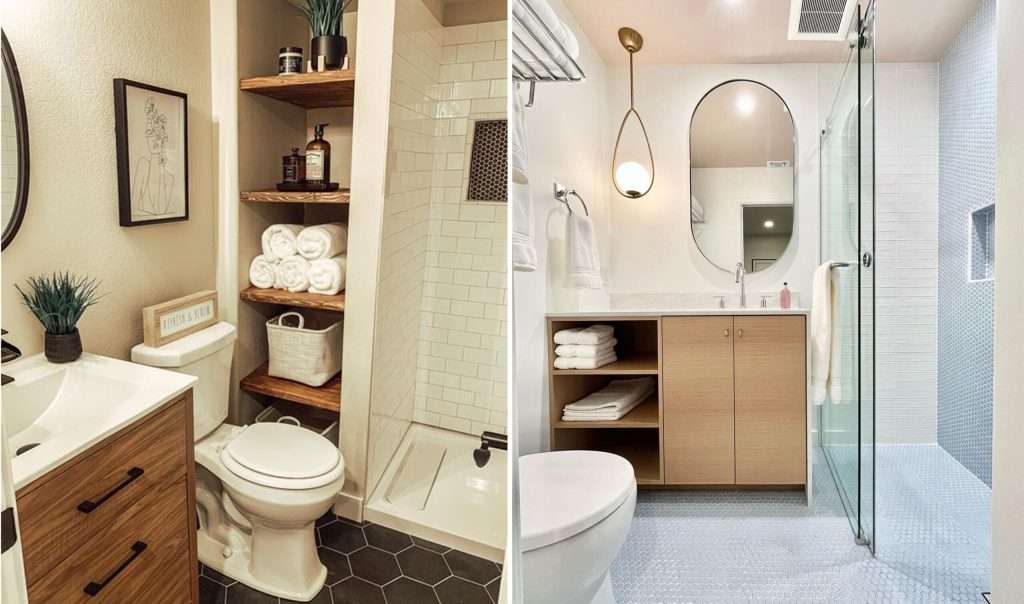Designing a Small Bathroom: Maximizing Space and Style
Transform your cramped bathroom into a stylish oasis! Discover clever space-saving solutions and inspiring design ideas to maximize your small bathroom’s potential. Get ready to be amazed by what you can achieve!

Designing a small room, especially one that incorporates a bathroom, presents unique challenges. Space is often at a premium, requiring careful planning and creative solutions. However, with the right approach, you can transform a cramped area into a functional and stylish sanctuary. This article explores various design strategies, from clever storage solutions to thoughtful color palettes, to help you achieve the bathroom of your dreams, even in a small space. Let’s delve into the exciting possibilities.
Optimizing Space: Layout and Functionality
The foundation of any successful small bathroom design lies in optimizing the layout. Consider the placement of your fixtures carefully. A well-planned layout can significantly enhance the feeling of spaciousness. For example, a corner sink can free up valuable floor space, while a wall-mounted toilet can create an airier atmosphere. Think vertically! Utilize wall space to its full potential with shelves and cabinets. This keeps items off the floor and adds a sense of organization.
Choosing the Right Fixtures
Selecting the right bathroom fixtures is crucial in maximizing limited space. Opt for compact toilets, sinks, and showers. Consider space-saving shower designs like walk-in showers, which eliminate the need for bulky shower doors and enclosures. Look for features like built-in shelving within the shower to maximize storage without cluttering the floor. Remember, less is often more in a small space; prioritize functionality over unnecessary extras.
Clever Storage Solutions
Storage is often the biggest challenge in small bathrooms. Creative storage solutions are key to keeping the space clutter-free and organized. Recessed cabinets built into the walls are a fantastic way to maximize storage without compromising floor space. Consider installing floating shelves above the toilet or sink for toiletries and towels. Utilize the space under the sink with drawers or pull-out organizers. Even small details, such as using over-the-door organizers, can make a difference.
Color and Light: Creating an Illusion of Space
The strategic use of color and light can dramatically impact the perceived size of a small bathroom. Light, bright colors like whites, creams, and pastels, reflect light, making the space feel larger and more open. Avoid dark colors, which can make the room feel smaller and more cramped. Maximize natural light by keeping windows unobstructed. If natural light is limited, incorporate ample artificial lighting. Consider recessed lighting or strategically placed vanity lights to brighten the space.
Mirror, Mirror on the Wall
Mirrors are a powerful design tool for small bathrooms. A large mirror on the wall can visually double the space, creating an illusion of grandeur. Consider a full-length mirror or a mirrored medicine cabinet to maximize the effect. Strategically placed mirrors can also reflect light, further brightening the room. Remember to choose a mirror that complements the overall style of your bathroom.
Lighting Strategies for Small Spaces
Proper lighting is paramount in a small bathroom. Layer your lighting with a combination of ambient, task, and accent lighting. Ambient lighting provides general illumination, while task lighting focuses on specific areas, such as the sink or shower. Accent lighting can highlight architectural details or artwork. Consider using LED lights, which are energy-efficient and produce bright, even light. Avoid harsh overhead lighting, which can create shadows and make the space feel smaller.
Materials and Finishes: Choosing the Right Texture
The materials and finishes you choose can significantly impact the overall look and feel of your small bathroom. Light-colored tiles, for instance, can create a sense of spaciousness. Consider using large format tiles to minimize grout lines, creating a cleaner, more modern aesthetic. Natural materials like wood or stone can add warmth and texture, but use them sparingly in smaller spaces to prevent overwhelming the room. Avoid heavy, dark materials that can make the space feel cramped.
- Light-colored tiles: Reflect light and make the space feel larger.
- Large-format tiles: Minimize grout lines for a cleaner look.
- Natural materials (sparingly): Add warmth and texture without overwhelming the space.
- Avoid heavy, dark materials: These can make the space feel smaller and darker.
Incorporating Style: Personal Touches
While functionality is paramount in a small bathroom, don’t neglect style! Adding personal touches can transform the space into a welcoming and enjoyable retreat. Consider incorporating artwork, plants, or decorative accessories to personalize the space; Choose items that reflect your personality and create a cohesive design. Remember that less is often more; avoid overcrowding the space with too many accessories.
Adding Greenery
Small plants can add life and vibrancy to a small bathroom. Choose plants that thrive in humid environments, such as orchids or ferns. Place them strategically on shelves or windowsills to maximize natural light. However, avoid overcrowding the space with too many plants; a few carefully chosen plants can make a significant difference.
Textiles and Accessories
Textiles and accessories can add warmth and personality to a small bathroom. Choose towels and bath mats in coordinating colors and patterns to create a cohesive look. Add small decorative items, such as candles or soap dishes, to add personal touches. Remember to keep accessories minimal to avoid cluttering the space.
Maximizing Vertical Space: Utilizing Walls
Vertical space is often underutilized in small bathrooms. Make the most of it by installing tall cabinets that reach the ceiling. This maximizes storage capacity without taking up valuable floor space. Tall, narrow cabinets are ideal for small spaces, as they take up less floor area than wider cabinets. Consider using the back of the bathroom door for storage as well.
- Tall cabinets: Maximize storage without sacrificing floor space.
- Narrow cabinets: Ideal for smaller bathrooms.
- Back of the door: Utilize this often-overlooked space for storage.
- Wall-mounted shelves: Provide additional storage for toiletries and towels.
Budget-Friendly Design Solutions
Designing a stylish and functional small bathroom doesn’t have to break the bank. There are many budget-friendly solutions available. Repurposing existing items, such as using old jars as storage containers, can save money and add a unique touch. Shopping for sales and clearance items can also help you stretch your budget further. Remember, small changes can make a big difference.
Consider DIY projects to further reduce costs. Painting the walls or replacing cabinet hardware can dramatically update the look of your bathroom without requiring extensive renovations. Focus on simple upgrades that can transform the overall aesthetic. Prioritize the most impactful changes first, and tackle smaller projects gradually.
Ultimately, designing a small room with a bathroom is about making the most of the space you have. By carefully considering the layout, color palette, lighting, and storage solutions, you can create a beautiful and functional space that reflects your personal style. Remember to prioritize functionality, choose light and bright colors, and maximize vertical space. With a little creativity and planning, you can transform your small bathroom into a haven of style and comfort.
The process might seem daunting at first, but breaking it down into manageable steps and focusing on your priorities will yield rewarding results. Don’t be afraid to experiment with different ideas and find what works best for your unique needs and preferences. Embrace the challenges, and enjoy the transformation! The final result will be a testament to your ingenuity and a space you can truly cherish. A well-designed small bathroom can be just as luxurious and inviting as a larger one; it simply requires a more strategic approach.







